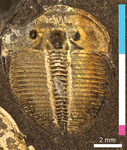
KLUG Christian
- Paläontologisches Institut und Museum, Universität Zürich, Zürich, Switzerland
- Evo-Devo, Evolutionary biology, Fossilization, Fossil record, Invertebrate paleontology, Macroecology, Macroevolution, Paleobiodiversity, Paleobiology, Paleoecology, Paleoenvironments, Paleopathology, Taphonomy, Taxonomy, Vertebrate paleontology
- recommender
Recommendation: 1
Reviews: 0
Recommendation: 1

A simple generative model of trilobite segmentation and growth
Deep insights into trilobite development
Recommended by Christian Klug based on reviews by Kenneth De Baets and Lukas LaiblTrilobites are arthropods that became extinct at the greatest marine mass extinction over 250 Ma ago. Because of their often bizarre forms, their great diversity and disparity of shapes, they have attracted the interest of researchers and laypersons alike. Due to their calcified exoskeleton, their remains are quite abundant in many marine strata. One particularly interesting aspect, however, is the fossilization of various molting stages. This allows the reconstruction of both juvenile strategies (lecitotrophic versus planktotrophic) and the entire life history of at least some well-documented taxa (e.g., Hughes 2003, 2007; Laibl 2017). For example, life history of trilobites is, based on certain morphological changes, classically subdivided in the three phases protaspis (hatchling, one dorsal shield with few segments with no articulation between), meraspis (juvenile, two and more shields connected by articulations) and holaspis (when the terminal number of thoracic segments is reached). At most molting events, a new skeletal element is added (only in the holaspis, the number of thoracic segments does not change). Nevertheless, many trilobites are known mainly from late meraspid and holaspid stages, because the dorsal shields of the first ontogenetic stages are usually very small and thus often either dissolved or overlooked. An improved understanding of trilobite ontogeny could thus help filling in these gaps in fossil preservation and subsequently, to better understand evolutionary pathways. This is where this paper comes in. In a very clever approach, the New-York-based researcher Melanie Hopkins modeled the growth of these segmented animals (Hopkins 2020). Previous growth models of invertebrates focused on, e.g., mollusks, whose shells grow by accretion. Modelling arthropod ontogeny represented a challenge, which is now overcome by Hopkins' brilliant paper. Her generative growth model is based on empirical data of *Aulacopleura koninckii* (Barrande, 1846). Hong et al. (2014) and Hughes et al. (2017) documented the ontogeny of this 429 Ma old trilobite species in great detail. In the Silurian of the Barrandian region (Czech Republic), this species is locally very common and all growth stages are well known. I could imagine that the paper of Hughes et al. (2017) planted the seed into Melanie Hopkins’ mind to approach trilobite development in general in a quantitative way with a mathematical approach comparable to the mollusk-research by, e.g., David Raup (1961, 1966) and George McGhee (2015). Hopkins’ growth model requires “a minimum of nine parameters […] to model basic trilobite growth and segmentation, and three additional parameters […] to allow a transition to a new growth gradient for the trunk region during ontogeny” (Hopkins 2020: p. 21). It is now possible to play with parameters such as protaspid size, segment dimensions, segment numbers, etc., in order to estimate changes in body size or morphology. Furthermore, the model could be applied to similarly organized arthropod exoskeletons like many early Cambrian arthropods (e.g., marellomorphs) or even crustaceans (e.g., conchostracans or copepods). Of great interest could also be to assess influences of environmental changes on arthropod ontogeny. Also, her work will help to reconstruct unknown developmental information missing from trilobite species (and possibly other arthropods) and also to explore their morphospace. **References** Barrande, J. (1846). Notice préliminaire sur le système Silurien et les trilobites de Bohême. Leipzig: Hirschfield. Hong, P. S., Hughes, N. C., & Sheets, H. D. (2014). Size, shape, and systematics of the Silurian trilobite *Aulacopleura koninckii*. Journal of Paleontology, 88(6), 1120–1138. doi: [ 10.1666/13-142](https://dx.doi.org/ 10.1666/13-142) Hopkins, M. J. (2020). A simple generative model of trilobite segmentation and growth. PaleorXiv, version 3, peer-reviewed by PCI Paleo. doi: [ 10.31233/osf.io/zt642](https://dx.doi.org/ 10.31233/osf.io/zt642) Hughes, N. C. (2003). Trilobite tagmosis and body patterning from morphological and developmental perspectives. Integrative and Comparative Biology, 43(1), 185–206. doi: [ 10.1093/icb/43.1.185](https://dx.doi.org/ 10.1093/icb/43.1.185) Hughes, N. C. (2007). The evolution of trilobite body patterning. Annual Review of Earth and Planetary Sciences, 35(1), 401–434. doi: [ 10.1146/annurev.earth.35.031306.140258](https://dx.doi.org/ 10.1146/annurev.earth.35.031306.140258) Hughes, N. C., Hong, P. S., Hou, J., & Fusco, G. (2017). The development of the Silurian trilobite *Aulacopleura koninckii* reconstructed by applying inferred growth and segmentation dynamics: A case study in paleo-evo-devo. Frontiers in Ecology and Evolution, 5, 00037. doi: [ 10.3389/fevo.2017.00037](https://dx.doi.org/ 10.3389/fevo.2017.00037) Laibl, L. (2017). Patterns in Palaeontology: The development of trilobites. Palaeontology Online, 7(10), 1–9. McGhee, G. R. (2015). Limits in the evolution of biological form: a theoretical morphologic perspective. Interface Focus, 5(6), 20150034. doi: [ 10.1098/rsfs.2015.0034](https://dx.doi.org/ 10.1098/rsfs.2015.0034) Raup, D. M. (1961). The geometry of coiling in gastropods. Proceedings of the National Academy of Sciences, 47(4), 602–609. doi: [ 10.1073/pnas.47.4.602](https://dx.doi.org/ 10.1073/pnas.47.4.602) Raup, D. M. (1966). Geometric analysis of shell coiling: general problems. Journal of Paleontology, 40, 1178–1190.